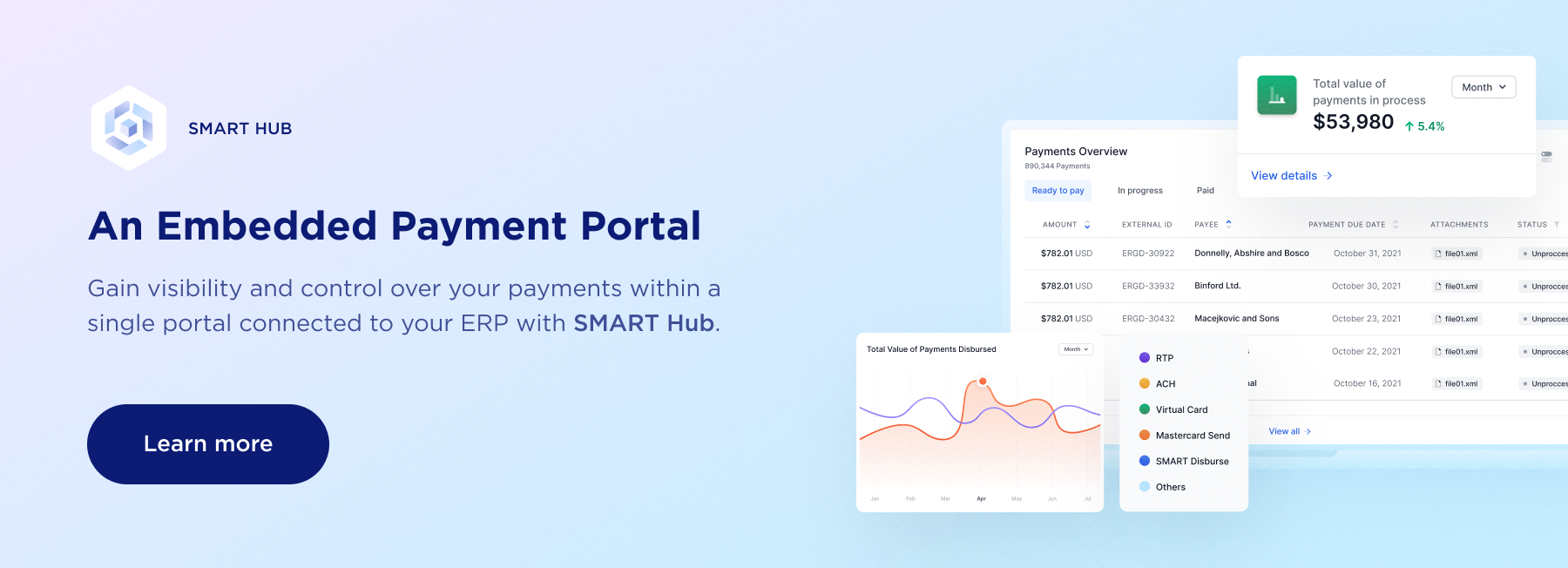Electronic payments are racing up the list of priorities of leaders at small and midsized businesses.
Business leaders recognize that paying individuals and suppliers electronically can free up working capital, reduce overhead through streamlined finance processes, enhance the customer experience, and strengthen supplier relationships – all of which are key to helping a business grow and succeed.
Half of CFOs from businesses with between $400 million and $750 million in revenue say that payments automation is “very” or “extremely” important to boosting their company’s balance sheet.
That’s according to the Business Payments Digitization report from PYMNTS and Corcentric.
Accelerating and streamlining inbound and outbound payment flows:
![]() Reduces the possibility of late payment penalties
Reduces the possibility of late payment penalties
![]() Creates more opportunities to capture early payment discounts
Creates more opportunities to capture early payment discounts
![]() Improves the accuracy of cash forecasting
Improves the accuracy of cash forecasting
![]() Provides the business with greater leverage during contract talks
Provides the business with greater leverage during contract talks
Here are some of the ways that electronic payments improve a small company’s balance sheet:
- Electronic payments cost one-thirtieth as much as paper checks, NACHA reports.
- Electronic payments account for one-tenth as much fraud as paper checks, NACHA reports.
- Electronic methods enable businesses to better control the timing of disbursements.
- Some card programs allow businesses to extend DPO without affecting payment terms.
- Electronic payments provide real-time visibility into cash flow for more accurate forecasting.
Digital payments provide a solid foundation for growing SMBs.
Why SMBs are digitizing their payments
Seventy-one percent of the CFOs surveyed by PYMNTS reported that their business is making more payments via card, direct deposit, PayPal, and other digital methods since the start of the pandemic.
That’s not say that every small and midsized business has embraced electronic disbursements.
The smaller the business, the higher the percentage of payments made via cash and checks, the Institute of Finance and Management (IOFM) reports. There are lots of reasons that small and midsized businesses cite for dragging their feet on digitizing payments to individuals and suppliers:
- Lack of IT resources
- Poor integration with existing back-office systems
- Lack of department resources to support a project
- Lack of capital budget
- No senior management support
- Fear of change
These challenges speak to the shortcomings of traditional approaches to payments digitization. On-premises payment solutions require complicated deployments, changes to existing processes, and custom integrations with legacy software and enterprise resource planning (ERP) applications. Onboarding individuals and suppliers to traditional digital payment solutions is labor-intensive and time-consuming.
Many digital payment solutions require users to log into separate portals to make multiple types of payments. Remittance details are manually generated. There’s no single place to see the status of all pending and in-process payments. And users must manually reconcile payments.
No wonder that some small and midsized businesses are reluctant to digitize their payments.
That’s why more small and midsized businesses are embedding digital payment solutions in their legacy software and ERP applications. Embedded payment solutions make it easy for accounts payable and accounts receivable staff to make and receive single or mass payments in an individual or supplier’s preferred method. Digital payments can be made instantly or scheduled for later.
The Working Capital Benefits of Embedded Payments
Embedded payment solutions can have a big impact on a small or midsized company’s balance sheet.
Lower Overhead
An embedded payment solution provides a single platform for making payments in any method (e.g., ACH, Real-Time Payment, virtual card, Mastercard Send), using any rails (including real-time payment rails), and from any originating bank account. Finance staff can complete payment processing with just a few clicks of the mouse from directly within the familiar screens of their legacy software or ERP. And seamless ERP integration facilitates real-time reconciliation of payment data.
Digitized payments cost significantly less than paper checks. And improving payments processing efficiency frees finance staff to focus more on growth-generating activities such as analyzing cash flow data, collaborating with coworkers, and building relationships with customers and suppliers.
Enhanced Visibility
Cash flow is critical to small and midsized businesses. Embedded payment solutions provide the real-time payment visibility that a growing business needs to manage its cash flow. Graphical dashboards display the top-line payment metrics that are most important to business owners. Users can instantly see all pending, in-process and completed payments.
Data can be effortlessly queried by method, amount, date, supplier, or other criteria. And drill down capabilities help staff uncover trends and opportunities to optimize their payments mix. These insights help a business put its cash flow to work faster.
Better Payment Timing
Tightly managed cash flow can help a small or midsized business reduce its borrowing costs, buy raw materials for manufacturing, and invest in growth initiatives. With an embedded payment solution, payments can be made instantly or scheduled for later.
Real-Time Payments can arrive in a payee’s account within moments. There’s never any chance that electronic payments will become lost in the mail or intercepted. All this helps CFOs and finance leaders better control payment timing.
Digital payments can improve a small or midsized business’ balance sheet.
Lower you business' overhead, enhance cash flow visibility, and tightly manage your payment timing — with embedded payment solutions.




